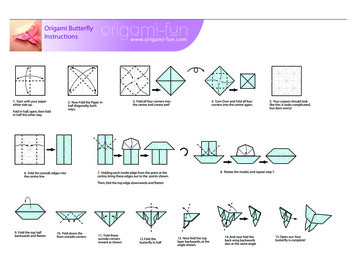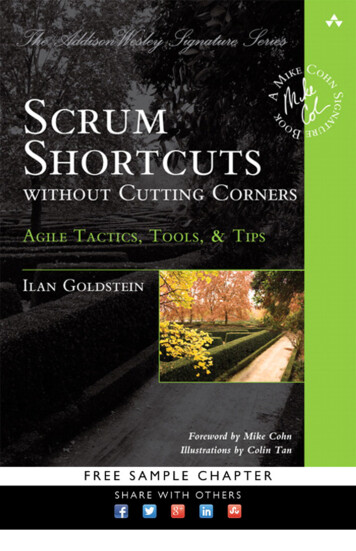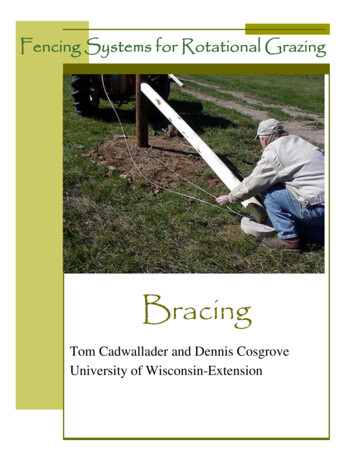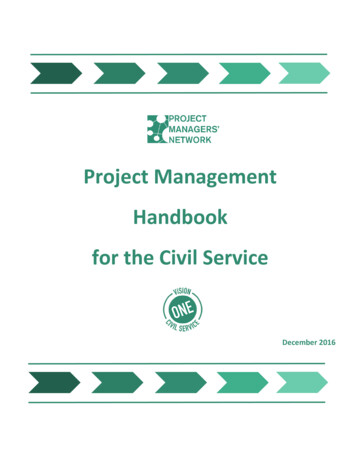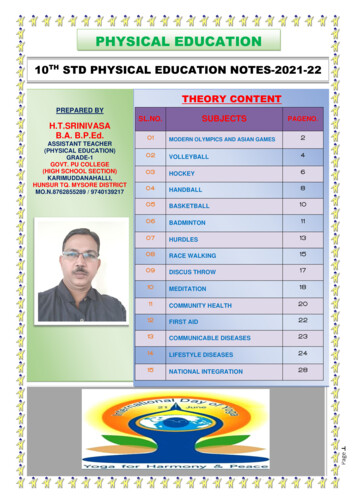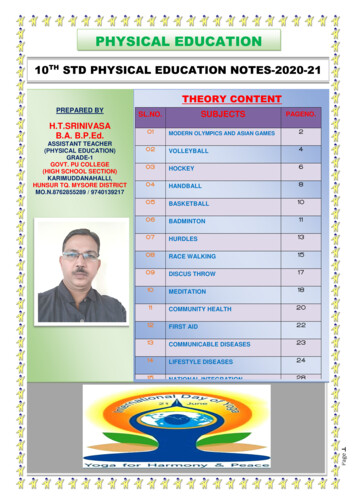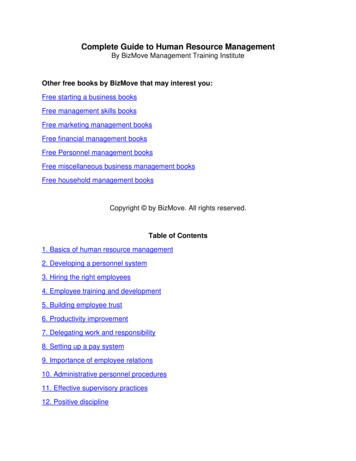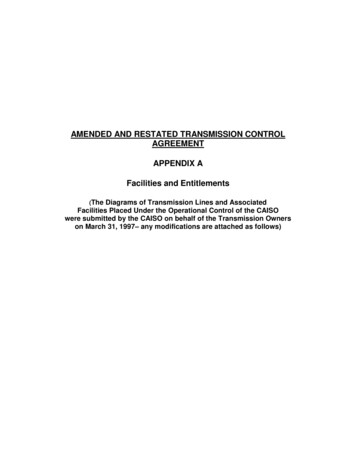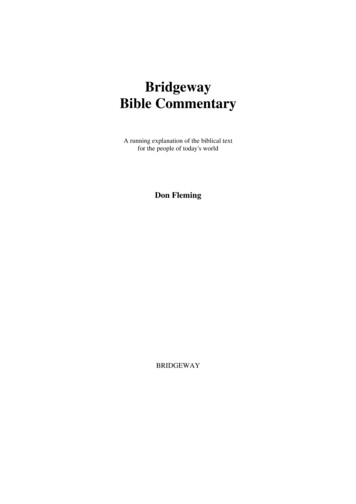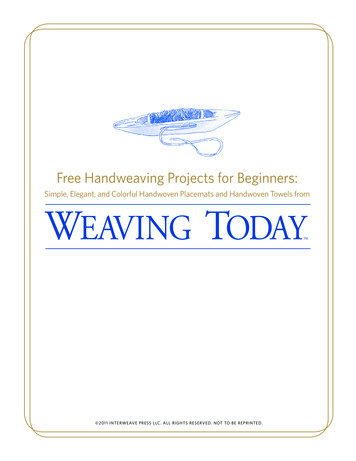
Transcription
Free Handweaving Projects for Beginners:Simple, Elegant, and Colorful Handwoven Placemats and Handwoven Towels fromTM 2011 inte rw e av e p r e ss llc. All ri ghts reserved. not to be repri nted.
Free Handweaving Projects for Beginners:Simple, Elegant, and Colorful Handwoven Placemats and Handwoven Towels fromTMAnything But PlainTwelve Placemats On One Warp!by Janet DawsonFrom Handwoven, November/December 2007; pp. 28–30.These placemats are all about color—and lots of it! The weave structure could not be simpler (just plain weave!), and theweaving is almost too easy. But watching the constantly shifting warp colors and using a different weft color for eachplacemat will hold your weaving interest for all of the eight yards. And when you are finished weaving, you’ll havetwelve different but beautifully coordinated placemats from just one warp!2Free Patterns from Weaving Today 2011 i nterweave press llc. All ri ghts reserved. not to be rep ri n t ed.
Free Handweaving Projects for Beginners:Simple, Elegant, and Colorful Handwoven Placemats and Handwoven Towels fromThe secret that gives this fabric a lively textureis the seemingly random warp color orderand the fact that every fourth and fifth warpthread work together. The random color order masksthe regular spacing of the doubled ends and tricksthe eye into thinking they, too, are randomly placed.As an added bonus, extra-bold lines of color (thatalso seem to occur randomly) stand out wherever thedoubled ends happen to be the same color.Warping tipsMany warp colors in an irregular order usually mean frequent cutting and tying at color changes when you windthe warp. Happily, this is not the case here! Five threads,each a different color, are wound together on the warpingboard. The warp is beamed with lease sticks in the crossformed by these groups of five threads, and the colors areselected randomly from each group as they are threaded.This process requires a back-to-front warping method. (If this warp were threaded before beaming, as infront-to-back warping, the five grouped ends would snarlat the heddles. With back-to-front warping, any twistingTMamong the five ends occurs between the back beam andthe heddles and is not a problem when tension is appliedduring weaving.) The method described here is adaptedfrom one used by Laura Fry; see Resources.Design suggestionsFor regular stripes rather than random ones, threadevery group of five threads the same way. Or, youcan reverse the order from one group to the next forwider, mirrored stripes.There are many ways to design a color palette forthis project other than the one used here—see theMay/June 2007 issue of Handwoven for ideas. Thetwo light, one medium, and two dark hues of thisproject warp are successful with a wide variety of weftcolors, but other schemes will be equally pleasing.Whatever you choose, you’ll be delighted by the colorblending that happens with each different weft.ResourcesFry, Laura. CD Weaver Series: You have to be Warped.Prince George, British Columbia: Laura Fry, 2004.PROJECT at-a-glanceWeave structure for runnerPlain weave.3Amounts include 3 yd of each color to un ply for endsand hemstitching.Equipment2- or 4-shaft loom, 14" weaving width; 10-dent reed;1 shuttle; two 1" 15" spacers (cardboard or mini-blinds).Yarn sourcesUnmercerized cotton and acrylic (Orlec) are availablefrom Maurice Brassard et Fils.YarnsWarp: 8/2 unmercerized cotton (3,360 yd/lb, Naturel#100 (natural) and Olive #1244 (olive); 8/2 acrylic(3,360 yd/lb), Indigo #917 (blue), Mais #935 (yellow),and Havane #922 (copper), 504 yd 22 5 oz) each.Weft: 8/8 unmercerized cotton (840 yd/lb), 80 yd (13 5oz) per placemat. Colors for placemats on page 2, leftto right: Framboise #5193 (raspberry), Orange Pâle#1315 (tangerine), Rouille #1316 (rust), Mauve #5153(dk purple), Plum #1732 (purple), Bleu #756 (lt blue),Sapin #5536 (green), Denim #5132 (blue), Seaton#5110 (lt green), Bourgogne #1770 (rose), Chamois #5069 (lt yellow), and Vieil Or #1418 (gold).Warp order and length280 ends 9 yd long (allows 26" for take-up, 33" forloom waste).Free Patterns from Weaving TodayWarp and weft spacingWarp: 20 epi (2/dent in a 10-dent reed). Width in thereed: 14".Weft: 9 ppi. Woven length (measured under tension onthe loom): 201 4" each placemat, 265" total; includes 2"fringe between mats.Finished dimensionsAfter washing, amounts produce twelve placemats121 2" 17" each plus 1" fringe. 2011 i nterweave press llc. All ri ghts reserved. not to be rep ri n t ed.
Free Handweaving Projects for Beginners:Simple, Elegant, and Colorful Handwoven Placemats and Handwoven Towels fromTMSteps for Weaving the Twelve Placemats123454Wind a warp of 280 total ends 9 yd long holding 5 endstogether (1 end each of Naturel, Olive, Indigo, Mais,and Havane). To do this, put a spool of each color ona spool rack (if you don’t have one, improvise one asin Photo a). You do not need to separate the threadswith your fingers as you wind. Because the 5 threads arewound together without an individual cross, a back-tofront warping method must be used (beaming beforethreading). For complete warping steps, see Resourcesat handwovenmagazine.com.a. Make a spoolrack with stackingcrates and dowels:Hang spools (allturning in thesame direction) ondowels and insertthe dowels throughthe sides of thecrates. Bring eachthread through adifferent hole inthe front side ofthe crate.Spread the warp in a raddle centering for 14", placelease sticks in the cross, and beam the warp underfirm and even tension.To thread: Identify the first group of 5 threads on thelease sticks. Smooth them so they are aligned (in anyorder) and thread them in that order. Take up the nextgroup; they are likely to be in a slightly different order.Thread them in their order, and continue. If the colors ofconsecutive groups of 5 fall in the same order, feel freeto change them to maintain a random look. The only ruleis that the 5 warp threads in each group stay togetherin one threading repeat to distribute the colors evenlyacross the width of the warp. Note that the repeat onfour shafts begins and ends on shaft 1, which places 2threads next to each other on shaft 1 as each new repeatis threaded. (If you have more than four shafts, you canuse the 5-shaft draft for a more straightforward threading order.)Free Patterns from Weaving Today3156Sley 2/dent in a 10-dent reed, tie the warp onto thefront apron rod, and weave a header with scrap yarnin plain weave to spread the warp.Each placemat uses a single color of 8/8 unmercerized cotton weft throughout, but begins and ends with4 picks and hemstitching in a finer (8/2) unmercerized cotton of the same color. The 8/8 unmercerizedcotton used here is actually four plies of 8/2 cotton.For each placemat, cut a length of 8/8 cotton 3 ydlong and separate the plies to produce four 3-ydlengths (you’ll need two of them for each mat). Windthe 8/8 cotton on the bobbin of a boat shuttle. Youcan use your fingers or a stick shuttle to weave withthe 8/2 cotton.41. Drafts for placemats7453231 1/4231 1/42/2/Leaving an 8/2 cotton tail three and a half times thewidth of the warp, entering the shed from the right, andstarting with the left treadle, weave 4 picks with the8/2, ending with the right treadle. Change sheds. Cutthe 8/2, tuck its end into the new shed from the right,and start the 8/8 cotton weft from the left. Weaveplain weave with 8/8 cotton. After 1", hemstitch thebeginning with the 8/2 tail. Include 2 picks and 5 endsin each stitch, keeping the doubled ends together. Thencontinue weaving until the placemat measures 20". Endthe 8/8 weft on the left side. With a second length of8/2 cotton, tuck an end into the same shed from theright, change sheds, and weave 4 picks. Hemstitch asat the beginning. Insert two spacers for fringe. Repeatfor each of 12 placemats using a different weft color foreach. You can experiment with colors other than thoseshown here; the neutral warp colors will go with almostany colors you choose. Remove spacers to hemstitch atthe beginning of each mat and insert them after you’vehemstitched it at the end.Remove the fabric from the loom; remove spacers.Machine wash, warm water, gentle cycle, with milddetergent. Air- or machine-dry, low, but hard presswith steam while still slightly damp. Cut placematsapart; trim fringes evenly. 2011 i nterweave press llc. All ri ghts reserved. not to be rep ri n t ed.
Free Handweaving Projects for Beginners:Simple, Elegant, and Colorful Handwoven Placemats and Handwoven Towels fromTMElegant Placematsby Suzie LilesFrom Handwoven, November/December 2009; pp. 60–61.5Free Patterns from Weaving Today 2011 i nterweave press llc. All ri ghts reserved. not to be rep ri n t ed.
Free Handweaving Projects for Beginners:Simple, Elegant, and Colorful Handwoven Placemats and Handwoven Towels fromSome years ago, I supported myself by selling myweaving at craft shows and outdoor markets.My best sellers were these placemats, and I soldhundreds of them. My favorite testimonial came froma bed-and-breakfast owner: she returned to buy morebecause the placemats washed so well and were so easyto use with varied table settings.The placemats can be woven in any colors, not justnatural. Natural yarn can be half the price of dyedyarn, however, so natural was my most profitableTMchoice. Placemats in natural also look more elegant—or formal—than colors and make great wedding gifts.The estimated times given here are much longerthan it takes me. After a few sets, you will get to be veryfast, close to halving these times.I sold my placemats at about 50 a set, though theyshould bring more now (four sets can be woven from a 30 three-pound cone). You’ll be able to weave four setsin about twenty hours to start—much less as youpractice!1. Draft for placematsPROJECT at-a-glance13x412x432Weave structure for runnerHuck and huck lace.11Equipment4-shaft loom, 15" weaving width; 12-dent reed;1 shuttle.Yarn sourcesUnmercerized cotton and acrylic (Orlec) areavailable from Maurice Brassard et Fils.2Warp length177 ends 31 2 yd long (allows 4" for take-up, 30"for loom waste; loom waste includes fringe).Warp and weft spacingWarp: 12 epi (1/dent in a 12-dent reed).Weft: 12 ppi.432321211211 1/Wind a warp of 177 ends 3 2 yd long(add 24" for each additional mat).Use your preferred method to warpthe loom following Figure 1./Weave following the selectedtreadling in Figure 1 for eachplacemat, hemstitching as shownbelow. Allow 4" unwoven warpbetween mats for fringe./1Remove the fabric from the loomand machine wash, gentle cycle.Machine dry. Remove and presswhile still partly damp. Trim fringeevenly to 11 /Free Patterns from Weaving Today2"///62"huck boxesFinished dimensionsWidth in the reed: 143 4". Woven length: 20" perplacemat plus fringe. Finished sizes: four placemats13" 18" each with 11 2" fringe at the ends.4////18x////1 12"//4 43//Weave all four mats in huck (topmat in the photo on page 5), inhuck lace (middle mat), or inhuck boxes (bottom mat)—orweave mixed sets.32 2huck lace314huckYarnsWarp: 3/2 pearl cotton (1,260 yd/lb, Eugene TextileCenter), natural, 620 yd. Weft: 3/2 pearl cotton,natural, 420 yd.2113x 1 2 3 4 5 6 74//2"/ 2011 i nterweave press llc. All ri ghts reserved. not to be rep ri n t ed.
Free Handweaving Projects for Beginners:Simple, Elegant, and Colorful Handwoven Placemats and Handwoven Towels fromTMThe fastest hemstitchingThread a weft tail three times as long as the warp width into a needle. Take the needle under the first 5 warp threads,around those 5 and up inside the loop made by the stitch (a). *For the next 5 warp threads, take the needle down atthe right of the 5 threads 2 weft rows above the bottom and bring it back up at the bottom left of the 5 threads (b).Take the needle around these 5 threads again and bring it up inside the loop made by the stitch (c). Repeat from *.bcphotos by Suzie Lilesabest ofeBooksDesigning andWeaving with BlocksNew Handwoven Collection CDsAvailable Now!A Baker’s Dozen13 Handwoven BagsDesigning to Weave & Sewt h e s e d o w n lo a d a b l e c o l l e c t i o n sa n d m a n y m o r e a r e a va i l a b l e n o w !TMs h o p. we a v i n g t o d a y. c o m(866) 949-16467Free Patterns from Weaving TodayTMshop.weavingtoday.com866-949-1646 2011 i nterweave press llc. All ri ghts reserved. not to be rep ri n t ed.
Free Handweaving Projects for Beginners:Simple, Elegant, and Colorful Handwoven Placemats and Handwoven Towels fromTMPlaying with Stripesby Jean KorusFrom Handwoven, March/April 2003; pp. 24–27.8Free Patterns from Weaving Today 2011 i nterweave press llc. All ri ghts reserved. not to be rep ri n t ed.
Free Handweaving Projects for Beginners:Simple, Elegant, and Colorful Handwoven Placemats and Handwoven Towels fromStriped and plaid towels Almost nothing is as satisfying as weaving dish towels.You’ll find these towels easy and fun to weave and apleasure to use. When planning a warp for towels, Iusually allow one yard per towel plus loom waste. Thisamount provides a little extra for experimenting.You can weave a great variety of different towelson a striped warp by varying color orders in the weft,so you’ll want to put on a long warp. The pleasureof playing with colors as you weave makes the extrawarping time worth every minute. Preparing the loomReview the directions in Project at-a glance (page 11)to make sure you have the equipment and materialsyou need. Add the totals of yarn required under Yarnsfor both warp and weft. If you are purchasing yarnfor the project, you will probably want to get 11 2 lb ofwhite 8/2 unmercerized cotton, 1 2 lb of blue (you need6 oz) and 3 4 to 1 lb of yellow (you need a little over 9oz). 8/2 cotton is always useful to have on hand, sohaving some left over is not a bad thing.There are several ways to wind a multicoloredwarp, but usually, if you are fairly new to warping,winding all of the colors in their correct order on theboard is the most foolproof. First check the warpcolor order in Figure 1, page 11 (read right to left).Note that the smallest number of consecutive ends ofone color is four. This means that you can hold twothreads together as you wind since you’ll have fourtotal threads if you make one complete round (fromfirst peg to last peg and back) on the board with twothreads. You may have to wind off a ball of yarn so thatyou have two yarn packages to wind from. Put any ballsin a gallon jar or deep bowl to keep them from tanglingwith threads coming from other balls or cones.You can cut and tie each new color to the old oneor you can try moving the yarn packages you are notusing out of the way to the side of the warping board,wrapping the strands a turn or two around a bottompeg, and unwrapping and bringing them back up as youneed them. This can be awkward, but it does save time.9Free Patterns from Weaving Today TM Follow the color order in Figure 1, reading fromright to left. The section in brackets is repeatedthree times. Begin by winding 40 ends of white (tencomplete rounds of the warping board holding twoends together). Be sure to keep a finger between thetwo threads as you wind so they cannot twist aroundeach other. Then wind 4 blue (one complete roundof two ends), then 4 white, and continue. When youhave wound the last 4 blue threads in the repeat,wind all the threads in the brackets again, and thenwind them a third time. End with 40 white. se whatever method you are most comfortableUwith to warp your loom. This can be front-to-backor back-to-front. If you need a warping refresher,go to Weaving Today (Free Resources/How-ToInstructions) or review warping steps in Learning toWeave by Deborah Chandler. I f you sley the reed before you thread (i.e., frontto-back), mark the center of the reed and measure123 4" from the center to one side and begin sleyingat this point; this will center the warp on the loom.If you use a raddle for beaming before threading,use the same method with the raddle. hen you beam the warp, it is important to ensureWthat the warp is wound evenly and firmly aroundthe beam. It should look like a cylinder, with nodifference in diameter between center and edges.Be sure your packing material (thick paper orwarping sticks) extends at least 1" beyond the edgesof the warp. T hread the loom following the draft in Figure 2, page11. The threading is a “straight draw,” i.e., 1-2-3-4.With it, you can weave plain weave (raising 1-3 vs2-4) or twill (1-2, 2-3, 3-4, 4-1). Note that there are508 ends distributed evenly on the shafts—you’llneed 127 heddles on each shaft. It’s a good idea tocount and move them before you start threading. Tie the warp onto the front apron rod in small groupsof threads, about 1 2" each. Take the group over theapron rod, divide it in two, and bring the two partsback up to tie over the undivided group. Tie one halfof a square knot for each group first, and then, when 2011 i nterweave press llc. All ri ghts reserved. not to be rep ri n t ed.
Free Handweaving Projects for Beginners:Simple, Elegant, and Colorful Handwoven Placemats and Handwoven Towels fromall groups are tied this way, go back and complete thesquare knot for each one. Start in the center and workout, alternating sides. Make the knots snug, not tight,and tie each group with the same degree of snugness.The width of the warp at the apron rod should beexactly the same as in the reed.Designing StripesDesigning with stripes is easy and fun! Try using watercolors or colored pencils and and simply paint or drawstripes on graph paper. When you find some you like,keep playing with their proportions. It is helpful to standback and look at them from a distance. When you aresatisfied, yarn wraps are a good next step. They can helpyou see how the actual colors of the yarn interact witheach other.Towels are a great way to experiment with stripedesign. They are easy to weave, and if you don’t likethe way they turn out, they will still dry dishes!Stripes can be designed for both warp and weft.You can use weft stripes to make borders or create aplaid by repeating them throughout a piece. An easydesign step is to make a symmetrical plaid by using thesame stripe sequence in the weft as in the warp, butusing other sequences can be much more interesting.The first two towels on this warp are woven withan all-white weft, one in plain weave and one in twill, tomake stripes in the warp direction only. Towels 3 and4 show weft stripes as borders, and Towels 5–7 arestriped throughout to form plaids.When weaving borders, weave the first borderand then measure from the beginning of the towel.Multiply this number by 2 and subtract the productfrom the desired length of the towel to determinehow long to weave the center section. For example,in Towel 4 the border (including the 11 2" allowancefor hems) measures about 101 2". Therefore, for a 34"towel, weave 13" using only white in the center (101 2"x 2 21"; 34" – 21" 13").Any stripe arrangement that you use for a bordercan be repeated throughout the towel to make a plaid.Towel 5 uses the same stripe sequence as the borderin Towel 4, except it is repeated three times. The spacebetween repeats must be calculated to achieve thedesired length; in this case 31 2" is allowed betweenrepeats. Towels 6 and 7 show two different plaids.The same colors are used in warp and weft forthese towels, but you can use different colors for both.You’ll find that you’ll have the most fun if you try newcombinations, so run wild!10Free Patterns from Weaving TodayTMWeaving the towels U sing the white weft, weave several picks of plainweave. Check to see that the fell of the cloth formsa straight line. Where it waves toward the reed, thewarp threads are too loose. Where it waves towardyou, they are to tight. Tighten or loosen knots onthe apron rod as needed.I t is a weaver’s chore to figure out exactly howmuch weft in the shed prevents drawing in butdoes not form unsightly loops at the selvedges.The best way to achieve both goals is to place theweft in the shed at about a 30-degree angle; then,making sure that it is snug at the selvedge, closethe shed and beat. If you beat on an open shed, youmight inadvertently flatten the weft, removing theangle that is important for allowing weft take-up. When the fell is even, weave Towel 1 in plain weavewith the white weft for 34" (11 2" at each end is usedfor hems). Weave the second towel in twill for 34"(see Figure 1). Separate the towels with a threadof a contrasting color. When you weave twill, firsttry starting the treadling sequence with the shuttleentering from the left, and then try starting thesequence with the shuttle entering from the right. Theweft will catch all the selvedge threads starting fromone side (choose this one), but not from the other. Weave Towels 3–7 following the color orders givenin Figures 3a–3c in either plain weave or twill.As you weave, keep a measuring tape beside you. Countthe number of weft threads per inch and work tomaintain a consistent beat of about 20 picks per inch.Figures 3a–3c show how many picks or inchesto weave of each color. Measure the height of eachstripe sequence as you weave and try to see thatmirrored stripes in the same towel are the same size. 2011 i nterweave press llc. All ri ghts reserved. not to be rep ri n t ed.
Free Handweaving Projects for Beginners:Simple, Elegant, and Colorful Handwoven Placemats and Handwoven Towels fromFinishing the towels 3a. Towel 31. Warp color order3x44440 white232 4044444844124blue1923232yellow508whiteblueyellowTo begin and end weft colors,bring each weft tail around anedge thread and back into theshed for about 1". Begin a wefton the opposite side from whichthe previous weft ended in theplain-weave towels to reduceselvedge bulk. Changing sidesin the twill towels may throwoff the order that catches allselvedge threads.TM2. Draft for towels44 12"127x32plainweave31 1/42/44 43 32 211//twill64644/1 12"14"/461 12"1 12"6464 Remove the towels from theloom. Machine zigzag on bothsides of contrasting threadsand cut towels apart. Turn upedges 1 2" and then 1 2" again foreach hem. Machine stitch witha slightly longer stitch than fora regular seam.44 12" Machine wash in warmwater with a small amount ofdetergent and machine dry.Press while slightly damp.Towel 1 (plain weave)61 12"Towel 2 (right, twill)PROJECT at-a-glanceWeave structure for runnerPlain weave and 2/2 twill.Equipment4-shaft loom, 26" weaving width; 10-dent reed; 3 shuttles.11Warp order and length508 ends 7 1 2 yd long (allows 32" for take-up and loomwaste) following the color order in Figure 1. Add orsubtract 1 yd from warp length for a different numberof towels.YarnsWarp: 8/2 unmercerized cotton (3,360 yd/lb), white,1,740 yd (81 3 oz); blue, 630 yd (3 oz); yellow, 1,440 yd(67 8 oz).Weft: 8/2 unmercerized cotton (3,360 yd/lb), white,2,500 yd (12 oz); blue, 609 yd (3 oz); yellow, 470 yd(21 4 oz).Warp and weft spacingWarp: 20 epi (2/dent in a 10-dent reed). Width in thereed: 252 5".Weft: about 20 ppi. Woven length (measured undertension on the loom): 30–35". (Length will varydepending on the number of picks per inch.)Yarn sources8/2 cotton is available from most weaving suppliers.Finished dimensionsAmounts produce seven hemmed towels, 211 4" 27–31".Free Patterns from Weaving Today 2011 i nterweave press llc. All ri ghts reserved. not to be rep ri n t ed.
Free Handweaving Projects for Beginners:Simple, Elegant, and Colorful Handwoven Placemats and Handwoven Towels fromTM4 12"444413"44443c. Towels 6 and 7whiteblueyellow4 12"3 4152 12"401540154444444443 12"12Free Patterns from Weaving Today3"101550151044443 12"1015501510whiteblueyellowwhiteblueyellow3b. Towels 4 and 4302044 2011 i nterweave press llc. All ri ghts reserved. not to be rep ri n t ed.
Free Handweaving Projects for Beginners:Simple, Elegant, and Colorful Handwoven Placemats and Handwoven Towels fromTMHuck WindowsDish Towels in Linen and Laceby Marjorie EricksonFrom Handwoven, May/June 2003; pp. 28–31.13Free Patterns from Weaving Today 2011 i nterweave press llc. All ri ghts reserved. not to be rep ri n t ed.
Free Handweaving Projects for Beginners:Simple, Elegant, and Colorful Handwoven Placemats and Handwoven Towels fromIn the spring of 2001, the Mountain LoomCompany announced a contest for weaving guilds.The challenge was to weave a 4-shaft huck dishtowel on a Mountain Loom. The grand prize for theguild with the winning towel was an 8-shaft Mountain Table Loom. I belong to the Olympia WeaversGuild in Olympia, W ashington, which sponsorsseveral weaving workshops each year. The possibilityof winning a loom for guild members to use in ourworkshops was extremely t empting!I decided that for a dish towel, linen must bethe fiber of choice. Since I had no prior experienceusing either huck lace or linen, I gathered up all ofthe pertinent weaving books and magazines from mylibrary and got to work. Using the huck design paperin The Complete Book of Drafting for Handweavers (seeResources) and a pencil, I constructed a number of4-shaft huck designs. Two of them made it to theloom. The design used for the towel shown here is theone that my guild liked best. It also won a loom for us!Since then, I have woven many different towelsusing the same design. Playing with a wide range ofyarns and colors can be very rewarding. Yarn wrapsare a great way to explore the possibilities of colorjuxtaposition. Cut a strip of cardboard or mat boardabout 11 2" 5" and wrap yarn around the cardboardto duplicate the number of ends of the desired colorin the finished woven piece.HuckHuck is one of several structures in a category we calllace weaves; see A Glossary of Lace Weaves below. Inhuck, alternate groups of threads (usually five in eachgroup) weave either plain weave or floats. When warpand weft floats alternate, lacy holes form betweenthem (this is called huck lace). When plain weave andfloats alternate, delicious little circles show in theplain weave (this is called huck or huck texture). Botheffects are most visible when warp and weft are thesame color and light in value. Notice the small circlesformed by the blue threads in the photo above rightand the pink threads in the photo on page 16.14Free Patterns from Weaving TodayTMLace TipsExperiment with designing huck in squares of differentcolors by making several yarn wraps.The towelsFor two towels, wind a warp following Figure 2, page 17,and the Project at-a-glance, page 15. Yarn amounts allow28" loom waste. If you are new to linen and lace, wind3 yards instead of 21 2 so you can practice your beat; lacedesigns look best if woven to square.Linen can require some extra care. After windingthe warp, tie a choke at every yard in addition to tyingthe cross. Before removing the warp from the warpingboard, mist it lightly to discourage curling. Beam withfirm and even tension.To make the pattern easier to see as you weave,sley the reed so that the 3 center threads of each5-thread huck group fall in the same dent: In an8-dent reed, sley 2 in the first dent (centering for167 8", then sley 2–3 five times, then 2, and then 2–3across the width of the warp. End by sleying the last6 warp threads 2/dent. (The 5-thread huck groupsshould be sleyed as shown in Figure 1.) 2011 i nterweave press llc. All ri ghts reserved. not to be rep ri n t ed.
Free Handweaving Projects for Beginners:Simple, Elegant, and Colorful Handwoven Placemats and Handwoven Towels fromTo wind the bobbins, fold a small square of damp,tightly woven cloth around the linen yarn while itis winding. This will not only help in the bobbinwinding process, but it will also spare your finger andthumb from yarn burn.Weaving the towelsWhen you are ready to weave, lightly mist the warp infront of the reed and place a damp towel on the warpbehind the shafts. I soak my wound bobbins in waterand pat them dry prior to using them. (If you followthese steps, the weaving has to proceed in a timelymanner. Wet bobbins and warp cannot be left forweeks unattended.) Kati Reeder Meek, an expert inlinen weaving, puts a humidifier under the loom andweaves with dry bobbins. If your environment is a bithumid, adding moisture may be unnecessary.For the hem, weave 30 picks of plain weave(treadles 3 and 4 in Figure 1) with yellow. Place theweft in the shed, close the shed, beat lightly, open thenext shed, and beat very firmly. Bubbling the weft inTMthe center before closing the shed will help preventexcessive draw-in.Hemstitch over the last weft pick, encircling 5warp threads in each stitch. Open the next shed andinsert a 1 16" dowel. Leaving a tail of weft at least threetimes as long as the width of the warp, change shedsand weave 11 additional shots of plain weave withyellow. Slightly loosen the tension on the warp andpull out the dowel. Thread the tail in a needle andhemstitch over the first weft row of the 11, againencircling 5 warp threads per group. Weave the bodyof the towel following Figure 1; end with the samesteps for the dowel and the hemstitching as at thebeginning, but in reverse.FinishingApply Fray Check to the beginning and ending weftrows of each towel, allow to dry, and cut towels apart.Press under 1 4" and then another 1 2" at each end.Sew hems by hand. Machine wash twice, using hotwater for the wash cycle and cold water for the rinsePROJECT at-a-glanceWeave structure for towelsHuck and plain weave.Room and Halcyon Yarn, 16/2 (Bockens) linen fromLone Star Loom Room, 20/2 linen from Webs.Equipment4-shaft loom, 17" weaving width; 8-dent reed;3 shuttles, tapestry needle, 1 16" 18" dowel.Notions and other suppliesMatching sewing thread, Fray Check.YarnsWarp: 22/2 cottolin (3,500 yd/lb), yellow #272, 463 yd(21 8 oz); 20/2 linen (3,000 yd/lb), Royal, 225 yd(11 5 oz); 16/2 linen (2,400 yd/lb), bleached white,150 yd (1 oz).Weft: 22/2 cottolin (3,500 yd/lb), yellow #272, 315 yd(11 2 oz);
Free handweaving projects for beginners: simple, elegant, and colorful handwoven placemats and handwoven towels from Anything But Plain Twelve Placemats On One Warp! by Janet Dawson these placemats are all about color—and lots of it! the weave structure could not
